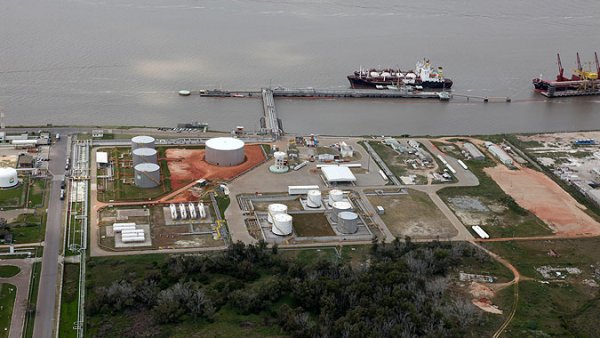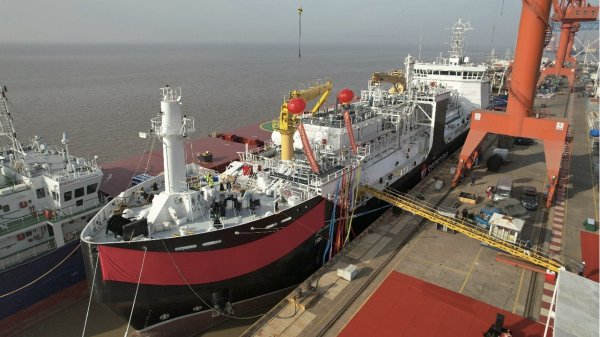Viking Line ferry set to save fuel with rotor sail retrofit
The Viking Grace is expected to cut LNG fuel use with the addition of Norsepower's technology.
Norsepower Oy Ltd, a provider of low-maintenance, software-operated, data-verified auxiliary wind propulsion systems, has announced that it has signed an agreement with Finnish shipping company Viking Line to install its Rotor Sail Solution technology on board the M/S Viking Grace - an LNG-fuelled cruise ferry.
The 57,565-grt M/S Viking Grace currently operates in the archipelago between Turku (Finland) and Stockholm Sweden). With the addition of Norsepower's technology, the vessel is expected to reduce its emissions, fuel burn and bunker costs - slashing carbon emissions by around 900 tonnes annually, which is equivalent to cutting 300 tonnes of LNG fuel per year.
Preparations for the retrofit are underway, with the installation scheduled to take place during the second quarter of 2018. Viking Grace is set to be retrofitted with one medium-sized Norsepower Rotor Sail unit that is 24 metres in height and 4 metres in diameter, making it the first-ever global LNG/wind electric propulsion hybrid ship.
The Norsepower Rotor Sail Solution, which can be installed on new vessels or retrofitted on existing ships without off-hire costs, is a modernised version of the Flettner rotor - a spinning cylinder that uses the Magnus effect to harness wind power to propel a ship. The solution is fully automated and senses whenever the wind is strong enough to deliver fuel savings, at which point the rotors start automatically - optimising crew time and resource.
Commenting on the technology, Ulf Hagstrom, Senior Vice President, Marine Operations & Newbuildings, Viking Line, said: "As an organisation that strives to ensure that our fleet operates in an environmentally friendly and economical way, we are proud to be partnering with Norsepower. Our cruise vessel is the first to use a combination of alternative clean fuels, modern Rotor Sails, electric propulsion, and a hydrodynamically optimised hull. We believe in the Rotor Sail Solution technology's ability to enhance our ship's performance by enabling significant reductions in fuel burn and costs, as well as carbon emissions."
Tuomas Riski, CEO, Norsepower remarked: "This project marks the first of its kind modern auxiliary wind propulsion technology installation onboard a cruise ferry. As a Finnish based clean technology and engineering company, we are proud to be partnering with yet another prominent shipping company as we work towards a modern era of auxiliary wind propulsion for the global maritime fleet, while supporting shipping's transition to the low carbon economy."
According to Norsepower, independent data analysis indicates that up to 20 percent fuel savings per year can be achieved on routes with favourable wind flows, sufficient-sized rotor sails, and appropriate service speed.
The technology has already been used in a commercial environment, with two small units of Norsepower's rotor sails installed on board Bore's M/S Estraden - a 9,700-deadweight-tonne (dwt) ro-ro carrier.
Measured and independently verified by NAPA, a Finnish maritime data analysis, software and services provider, the Rotor Sail Solution is said to have delivered fuel consumption reductions of 6.1 percent for the Estraden.
Bunker Index reported in August that Norsepower had been selected to receive EUR 2.6 million in funding to further its research and development of its Rotor Sail Solution technology. The new models of the technology will include the world's largest ever Flettner rotor.
The 57,565-grt M/S Viking Grace currently operates in the archipelago between Turku (Finland) and Stockholm Sweden). With the addition of Norsepower's technology, the vessel is expected to reduce its emissions, fuel burn and bunker costs - slashing carbon emissions by around 900 tonnes annually, which is equivalent to cutting 300 tonnes of LNG fuel per year.
Preparations for the retrofit are underway, with the installation scheduled to take place during the second quarter of 2018. Viking Grace is set to be retrofitted with one medium-sized Norsepower Rotor Sail unit that is 24 metres in height and 4 metres in diameter, making it the first-ever global LNG/wind electric propulsion hybrid ship.
The Norsepower Rotor Sail Solution, which can be installed on new vessels or retrofitted on existing ships without off-hire costs, is a modernised version of the Flettner rotor - a spinning cylinder that uses the Magnus effect to harness wind power to propel a ship. The solution is fully automated and senses whenever the wind is strong enough to deliver fuel savings, at which point the rotors start automatically - optimising crew time and resource.
Commenting on the technology, Ulf Hagstrom, Senior Vice President, Marine Operations & Newbuildings, Viking Line, said: "As an organisation that strives to ensure that our fleet operates in an environmentally friendly and economical way, we are proud to be partnering with Norsepower. Our cruise vessel is the first to use a combination of alternative clean fuels, modern Rotor Sails, electric propulsion, and a hydrodynamically optimised hull. We believe in the Rotor Sail Solution technology's ability to enhance our ship's performance by enabling significant reductions in fuel burn and costs, as well as carbon emissions."
Tuomas Riski, CEO, Norsepower remarked: "This project marks the first of its kind modern auxiliary wind propulsion technology installation onboard a cruise ferry. As a Finnish based clean technology and engineering company, we are proud to be partnering with yet another prominent shipping company as we work towards a modern era of auxiliary wind propulsion for the global maritime fleet, while supporting shipping's transition to the low carbon economy."
According to Norsepower, independent data analysis indicates that up to 20 percent fuel savings per year can be achieved on routes with favourable wind flows, sufficient-sized rotor sails, and appropriate service speed.
The technology has already been used in a commercial environment, with two small units of Norsepower's rotor sails installed on board Bore's M/S Estraden - a 9,700-deadweight-tonne (dwt) ro-ro carrier.
Measured and independently verified by NAPA, a Finnish maritime data analysis, software and services provider, the Rotor Sail Solution is said to have delivered fuel consumption reductions of 6.1 percent for the Estraden.
Bunker Index reported in August that Norsepower had been selected to receive EUR 2.6 million in funding to further its research and development of its Rotor Sail Solution technology. The new models of the technology will include the world's largest ever Flettner rotor.

|
IMO approves pricing mechanism based on GHG intensity thresholds
Charges to be levied on ships that do not meet yearly GHG fuel intensity reduction targets. |
|
|
|
||

|
VARO Energy expands renewable portfolio with Preem acquisition
All-cash transaction expected to complete in the latter half of 2025. |
|
|
|
||

|
NYK trials biofuel in milestone coal carrier test
Vessel is used to test biofuel for domestic utility company. |
|
|
|
||

|
H-Line Shipping orders LNG bunkering vessel
Vessel with 18,000-cbm capacity to run on both LNG and MDO. |
|
|
|
||

|
How to engineer and manage green shipping fuels | Stanley George, VPS
Effective management strategies and insights for evolving fuel use. |
|
|
|
||

|
Swedish government bans scrubber wastewater discharges
Discharges from open-loop scrubbers to be prohibited in Swedish waters from July 2025. |
|
|
|
||

|
MAN Energy Solutions achieves 100% load milestone for ammonia engine
Latest tests validate fuel injection system throughout the entire load curve. |
|
|
|
||

|
Petrobras secures ISCC EU RED certification for B24 biofuel blend at Rio Grande
Blend consisting of 24% FAME is said to have been rigorously tested to meet international standards. |
|
|
|
||

|
Stolt-Nielsen to fully control Avenir LNG with acquisition
Share purchase agreement to buy all shares from Golar LNG and Aequitas. |
|
|
|
||

|
Bureau Veritas supports launch of CIMC SOE's LNG bunkering vessel
Handover of Seaspan Energy's cutting-edge 7,600-cbm vessel completed. |
|
|
|
||
Related Links
- · EUR 2.6m funding to develop world's largest rotor sail [Insights]
- · Fuel-saving rotor sail business gets EUR 3m funding [Insights]
- · Milestone reached: Viking Grace has refuelled with LNG 1,000 times [Insights]
- · Finland [Directory]

